Form 8-K Cabaletta Bio, Inc. For: Jan 10
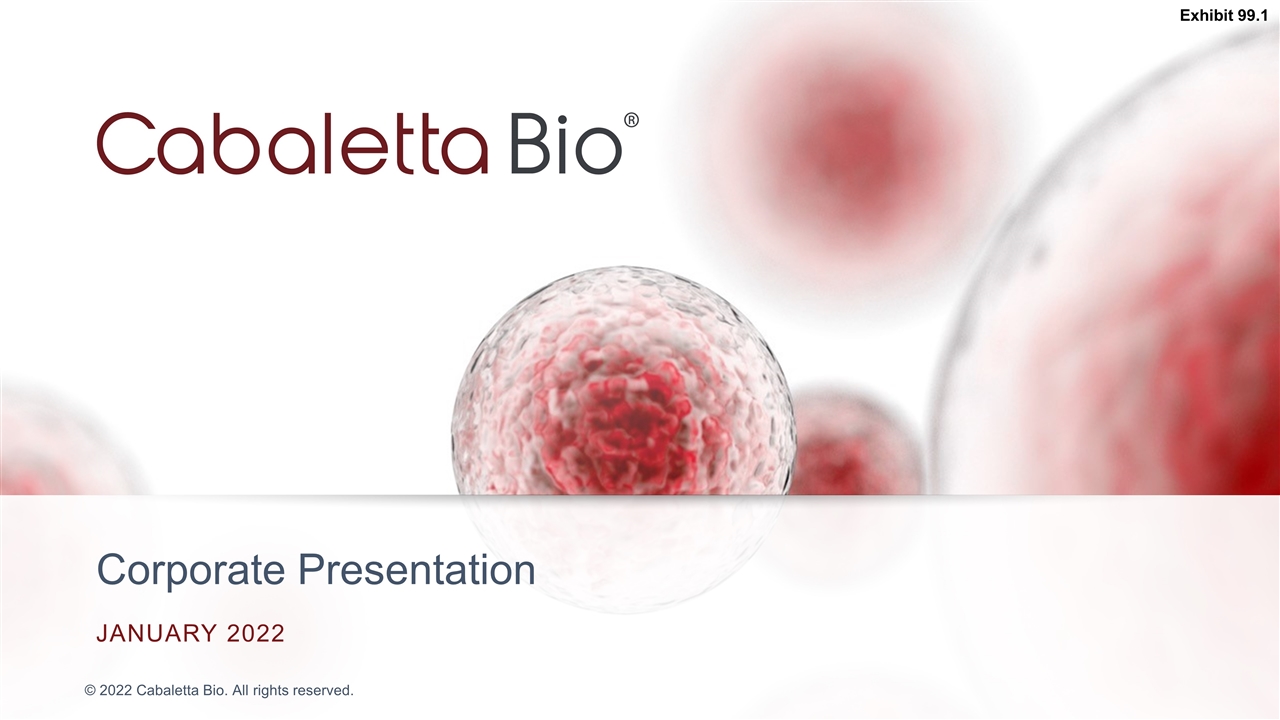
Corporate Presentation JANUARY 2022 Exhibit 99.1
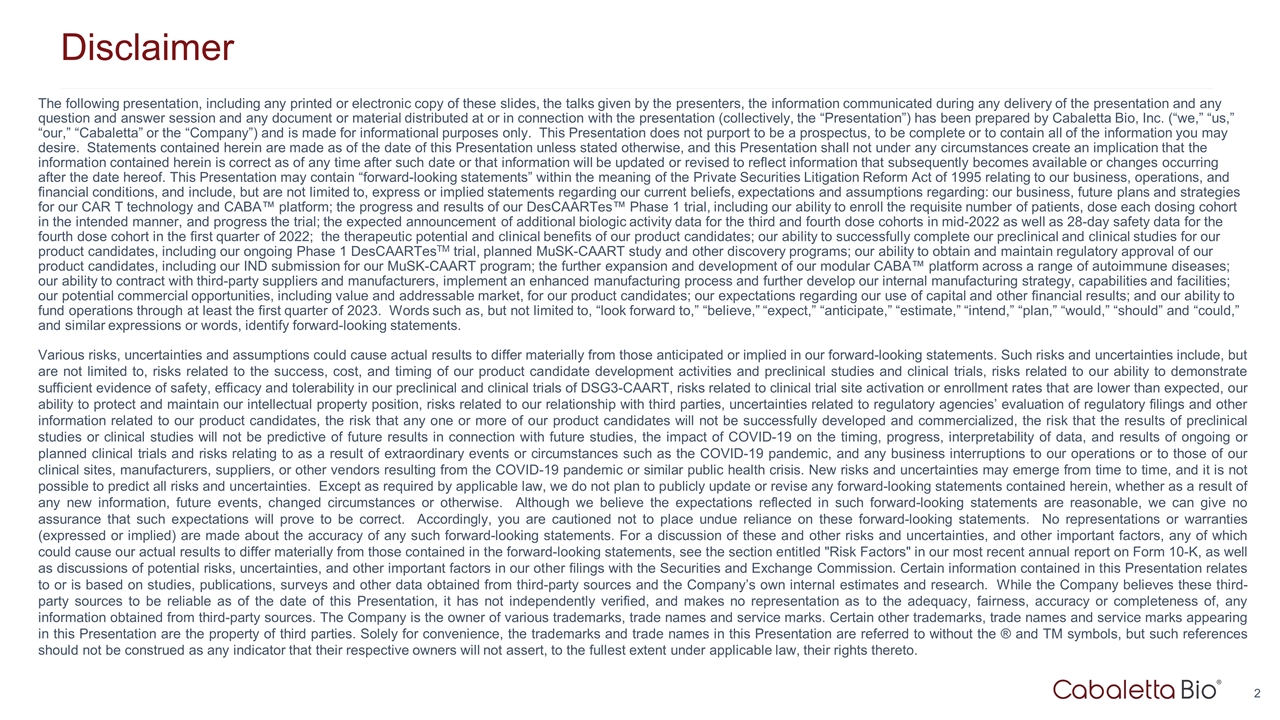
Disclaimer The following presentation, including any printed or electronic copy of these slides, the talks given by the presenters, the information communicated during any delivery of the presentation and any question and answer session and any document or material distributed at or in connection with the presentation (collectively, the “Presentation”) has been prepared by Cabaletta Bio, Inc. (“we,” “us,” “our,” “Cabaletta” or the “Company”) and is made for informational purposes only. This Presentation does not purport to be a prospectus, to be complete or to contain all of the information you may desire. Statements contained herein are made as of the date of this Presentation unless stated otherwise, and this Presentation shall not under any circumstances create an implication that the information contained herein is correct as of any time after such date or that information will be updated or revised to reflect information that subsequently becomes available or changes occurring after the date hereof. This Presentation may contain “forward-looking statements” within the meaning of the Private Securities Litigation Reform Act of 1995 relating to our business, operations, and financial conditions, and include, but are not limited to, express or implied statements regarding our current beliefs, expectations and assumptions regarding: our business, future plans and strategies for our CAR T technology and CABA™ platform; the progress and results of our DesCAARTes™ Phase 1 trial, including our ability to enroll the requisite number of patients, dose each dosing cohort in the intended manner, and progress the trial; the expected announcement of additional biologic activity data for the third and fourth dose cohorts in mid-2022 as well as 28-day safety data for the fourth dose cohort in the first quarter of 2022; the therapeutic potential and clinical benefits of our product candidates; our ability to successfully complete our preclinical and clinical studies for our product candidates, including our ongoing Phase 1 DesCAARTesTM trial, planned MuSK-CAART study and other discovery programs; our ability to obtain and maintain regulatory approval of our product candidates, including our IND submission for our MuSK-CAART program; the further expansion and development of our modular CABA™ platform across a range of autoimmune diseases; our ability to contract with third-party suppliers and manufacturers, implement an enhanced manufacturing process and further develop our internal manufacturing strategy, capabilities and facilities; our potential commercial opportunities, including value and addressable market, for our product candidates; our expectations regarding our use of capital and other financial results; and our ability to fund operations through at least the first quarter of 2023. Words such as, but not limited to, “look forward to,” “believe,” “expect,” “anticipate,” “estimate,” “intend,” “plan,” “would,” “should” and “could,” and similar expressions or words, identify forward-looking statements. Various risks, uncertainties and assumptions could cause actual results to differ materially from those anticipated or implied in our forward-looking statements. Such risks and uncertainties include, but are not limited to, risks related to the success, cost, and timing of our product candidate development activities and preclinical studies and clinical trials, risks related to our ability to demonstrate sufficient evidence of safety, efficacy and tolerability in our preclinical and clinical trials of DSG3-CAART, risks related to clinical trial site activation or enrollment rates that are lower than expected, our ability to protect and maintain our intellectual property position, risks related to our relationship with third parties, uncertainties related to regulatory agencies’ evaluation of regulatory filings and other information related to our product candidates, the risk that any one or more of our product candidates will not be successfully developed and commercialized, the risk that the results of preclinical studies or clinical studies will not be predictive of future results in connection with future studies, the impact of COVID-19 on the timing, progress, interpretability of data, and results of ongoing or planned clinical trials and risks relating to as a result of extraordinary events or circumstances such as the COVID-19 pandemic, and any business interruptions to our operations or to those of our clinical sites, manufacturers, suppliers, or other vendors resulting from the COVID-19 pandemic or similar public health crisis. New risks and uncertainties may emerge from time to time, and it is not possible to predict all risks and uncertainties. Except as required by applicable law, we do not plan to publicly update or revise any forward-looking statements contained herein, whether as a result of any new information, future events, changed circumstances or otherwise. Although we believe the expectations reflected in such forward-looking statements are reasonable, we can give no assurance that such expectations will prove to be correct. Accordingly, you are cautioned not to place undue reliance on these forward-looking statements. No representations or warranties (expressed or implied) are made about the accuracy of any such forward-looking statements. For a discussion of these and other risks and uncertainties, and other important factors, any of which could cause our actual results to differ materially from those contained in the forward-looking statements, see the section entitled "Risk Factors" in our most recent annual report on Form 10-K, as well as discussions of potential risks, uncertainties, and other important factors in our other filings with the Securities and Exchange Commission. Certain information contained in this Presentation relates to or is based on studies, publications, surveys and other data obtained from third-party sources and the Company’s own internal estimates and research. While the Company believes these third-party sources to be reliable as of the date of this Presentation, it has not independently verified, and makes no representation as to the adequacy, fairness, accuracy or completeness of, any information obtained from third-party sources. The Company is the owner of various trademarks, trade names and service marks. Certain other trademarks, trade names and service marks appearing in this Presentation are the property of third parties. Solely for convenience, the trademarks and trade names in this Presentation are referred to without the ® and TM symbols, but such references should not be construed as any indicator that their respective owners will not assert, to the fullest extent under applicable law, their rights thereto.

Develop and launch the first curative targeted cellular therapies for patients with autoimmune diseases
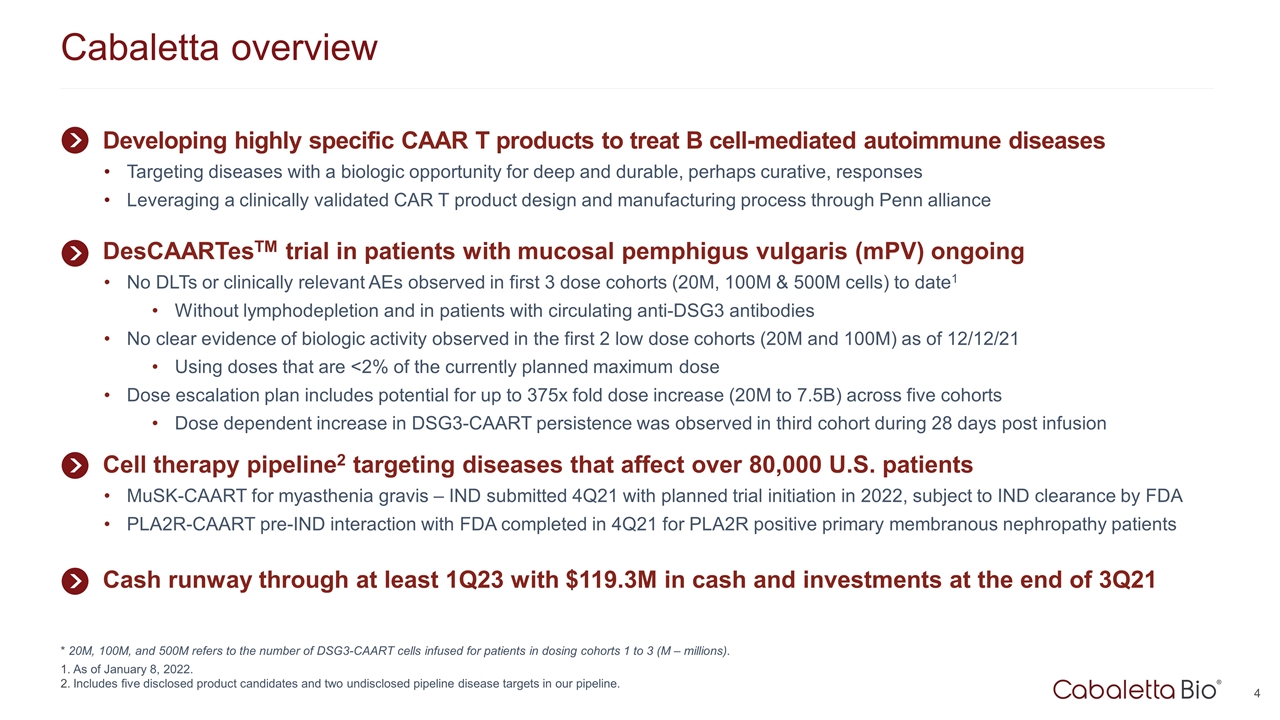
Cabaletta overview * 20M, 100M, and 500M refers to the number of DSG3-CAART cells infused for patients in dosing cohorts 1 to 3 (M – millions). As of January 8, 2022. Includes five disclosed product candidates and two undisclosed pipeline disease targets in our pipeline. Developing highly specific CAAR T products to treat B cell-mediated autoimmune diseases Targeting diseases with a biologic opportunity for deep and durable, perhaps curative, responses Leveraging a clinically validated CAR T product design and manufacturing process through Penn alliance Cash runway through at least 1Q23 with $119.3M in cash and investments at the end of 3Q21 Cell therapy pipeline2 targeting diseases that affect over 80,000 U.S. patients MuSK-CAART for myasthenia gravis – IND submitted 4Q21 with planned trial initiation in 2022, subject to IND clearance by FDA PLA2R-CAART pre-IND interaction with FDA completed in 4Q21 for PLA2R positive primary membranous nephropathy patients DesCAARTesTM trial in patients with mucosal pemphigus vulgaris (mPV) ongoing No DLTs or clinically relevant AEs observed in first 3 dose cohorts (20M, 100M & 500M cells) to date1 Without lymphodepletion and in patients with circulating anti-DSG3 antibodies No clear evidence of biologic activity observed in the first 2 low dose cohorts (20M and 100M) as of 12/12/21 Using doses that are <2% of the currently planned maximum dose Dose escalation plan includes potential for up to 375x fold dose increase (20M to 7.5B) across five cohorts Dose dependent increase in DSG3-CAART persistence was observed in third cohort during 28 days post infusion
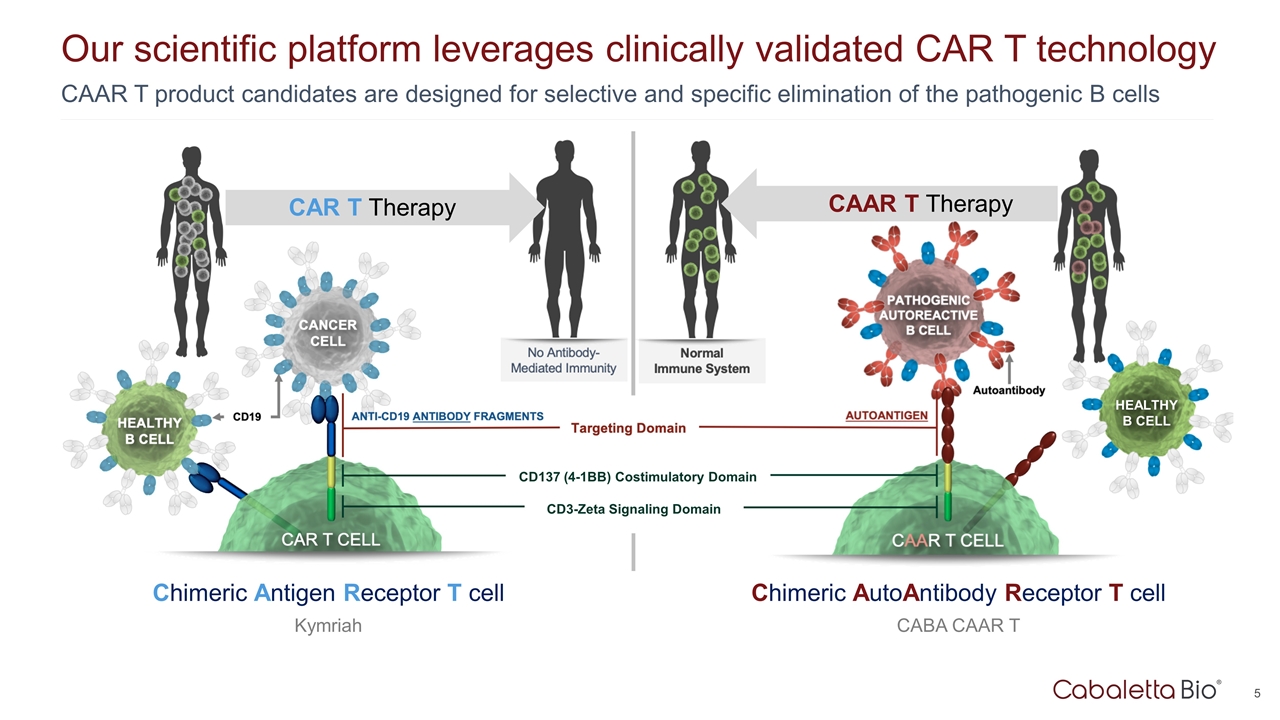
Our scientific platform leverages clinically validated CAR T technology CAR T Therapy Chimeric Antigen Receptor T cell Kymriah CAAR T product candidates are designed for selective and specific elimination of the pathogenic B cells CAAR T Therapy Chimeric AutoAntibody Receptor T cell CABA CAAR T CD137 (4-1BB) Costimulatory Domain CD3-Zeta Signaling Domain HEALTHY B CELL
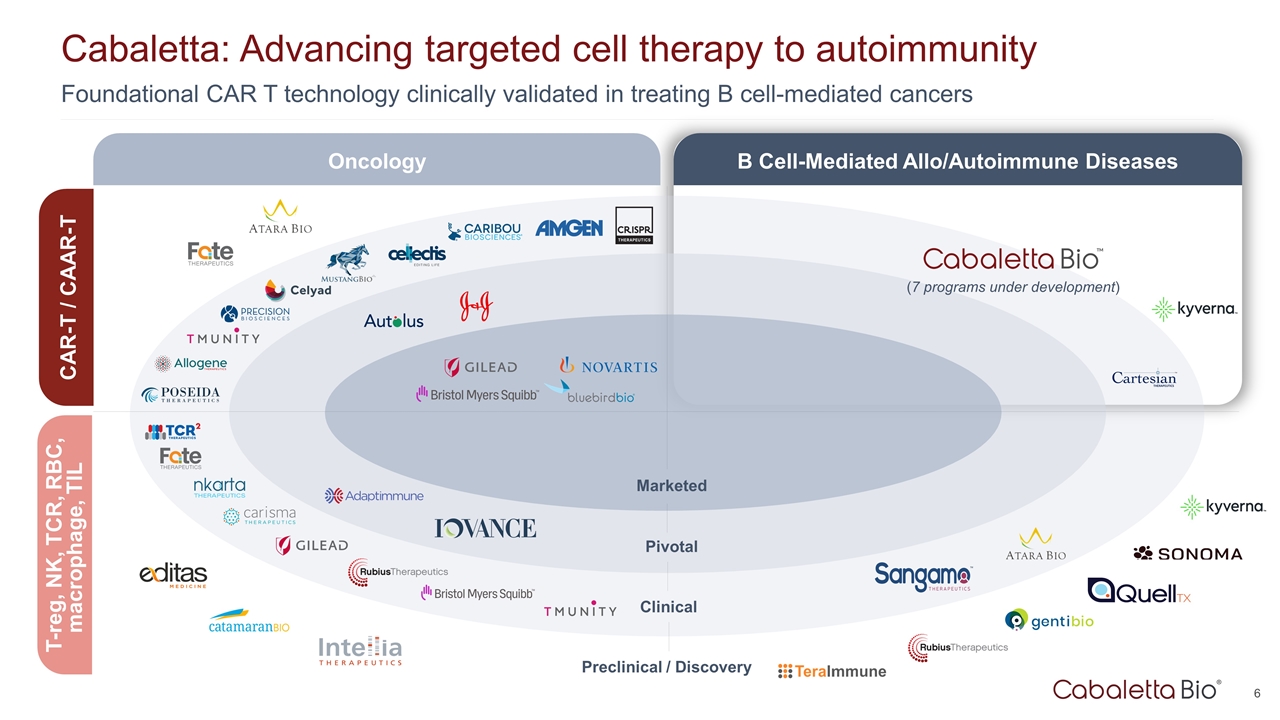
Foundational CAR T technology clinically validated in treating B cell-mediated cancers Cabaletta: Advancing targeted cell therapy to autoimmunity Marketed Pivotal Clinical Preclinical / Discovery Oncology B Cell-Mediated Allo/Autoimmune Diseases CAR-T / CAAR-T T-reg, NK, TCR, RBC, macrophage, TIL (7 programs under development)
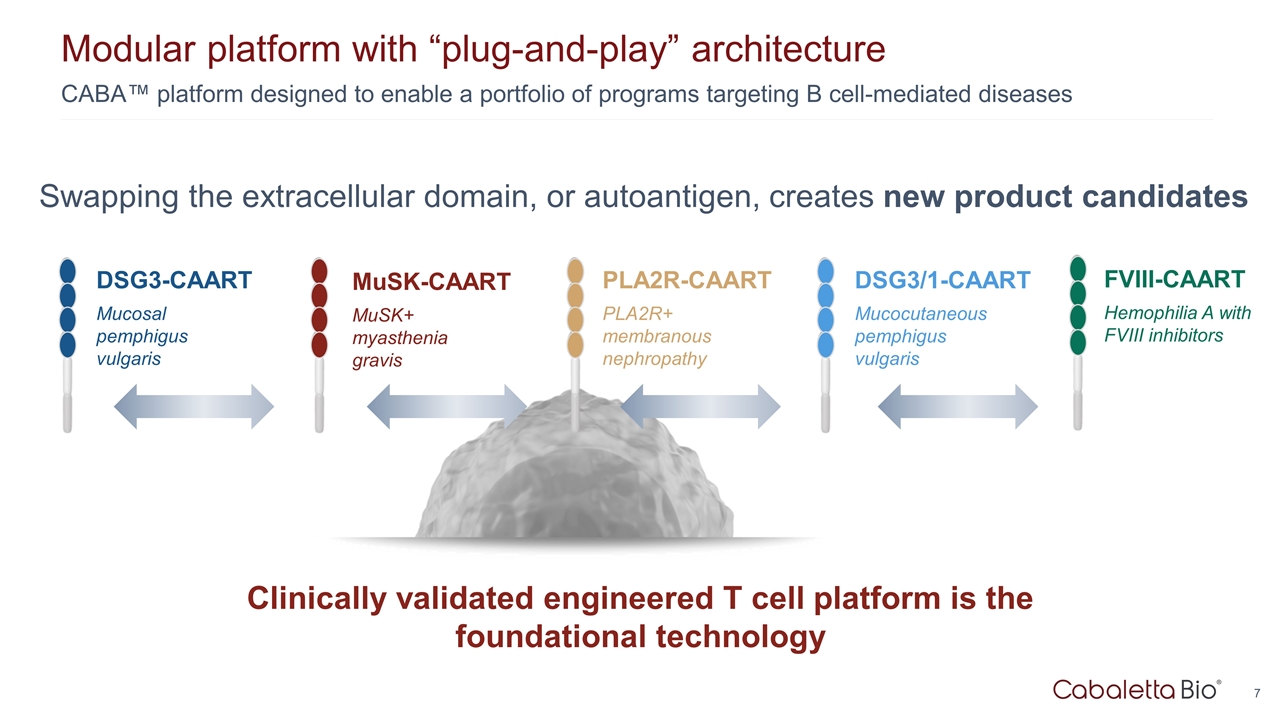
CABA™ platform designed to enable a portfolio of programs targeting B cell-mediated diseases Modular platform with “plug-and-play” architecture Clinically validated engineered T cell platform is the foundational technology PLA2R-CAART PLA2R+ membranous nephropathy DSG3-CAART Mucosal pemphigus vulgaris MuSK-CAART MuSK+ myasthenia gravis DSG3/1-CAART Mucocutaneous pemphigus vulgaris Swapping the extracellular domain, or autoantigen, creates new product candidates FVIII-CAART Hemophilia A with FVIII inhibitors
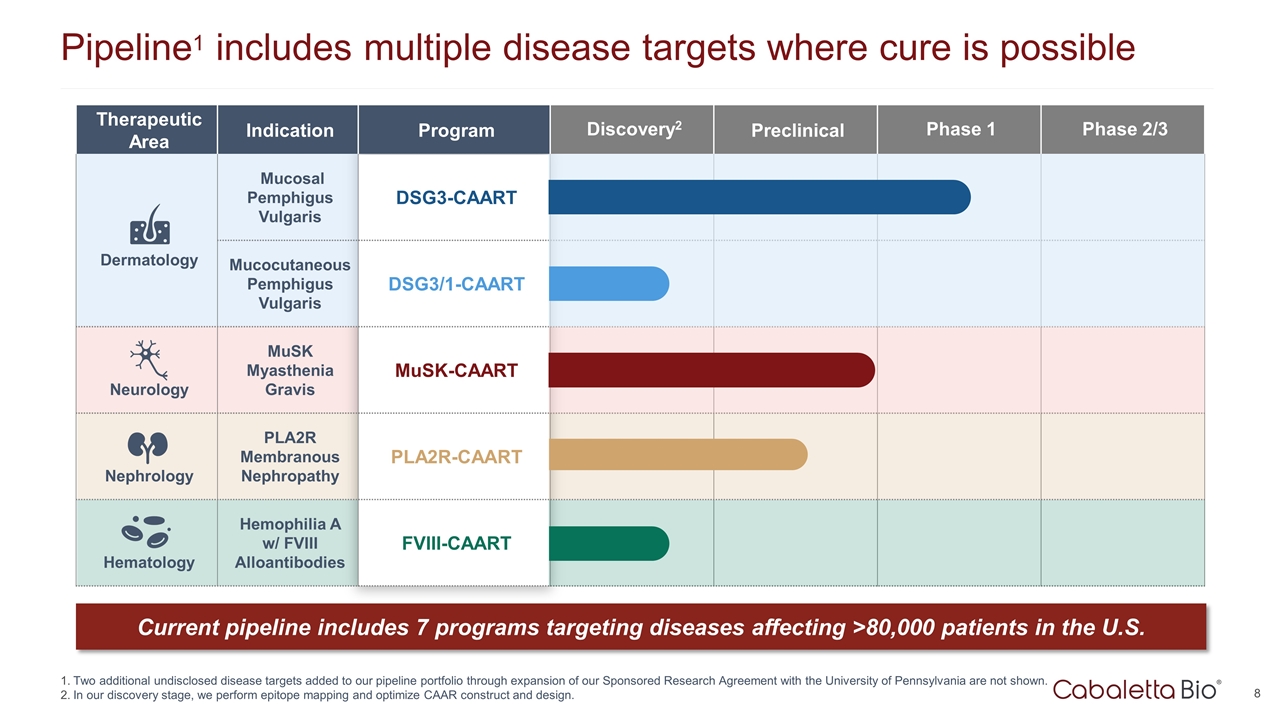
Therapeutic Area Indication Program Discovery2 Preclinical Phase 1 Phase 2/3 Dermatology Mucosal Pemphigus Vulgaris DSG3-CAART Mucocutaneous Pemphigus Vulgaris DSG3/1-CAART Neurology MuSK Myasthenia Gravis MuSK-CAART Nephrology PLA2R Membranous Nephropathy PLA2R-CAART Hematology Hemophilia A w/ FVIII Alloantibodies FVIII-CAART Pipeline1 includes multiple disease targets where cure is possible Two additional undisclosed disease targets added to our pipeline portfolio through expansion of our Sponsored Research Agreement with the University of Pennsylvania are not shown. In our discovery stage, we perform epitope mapping and optimize CAAR construct and design. Current pipeline includes 7 programs targeting diseases affecting >80,000 patients in the U.S.
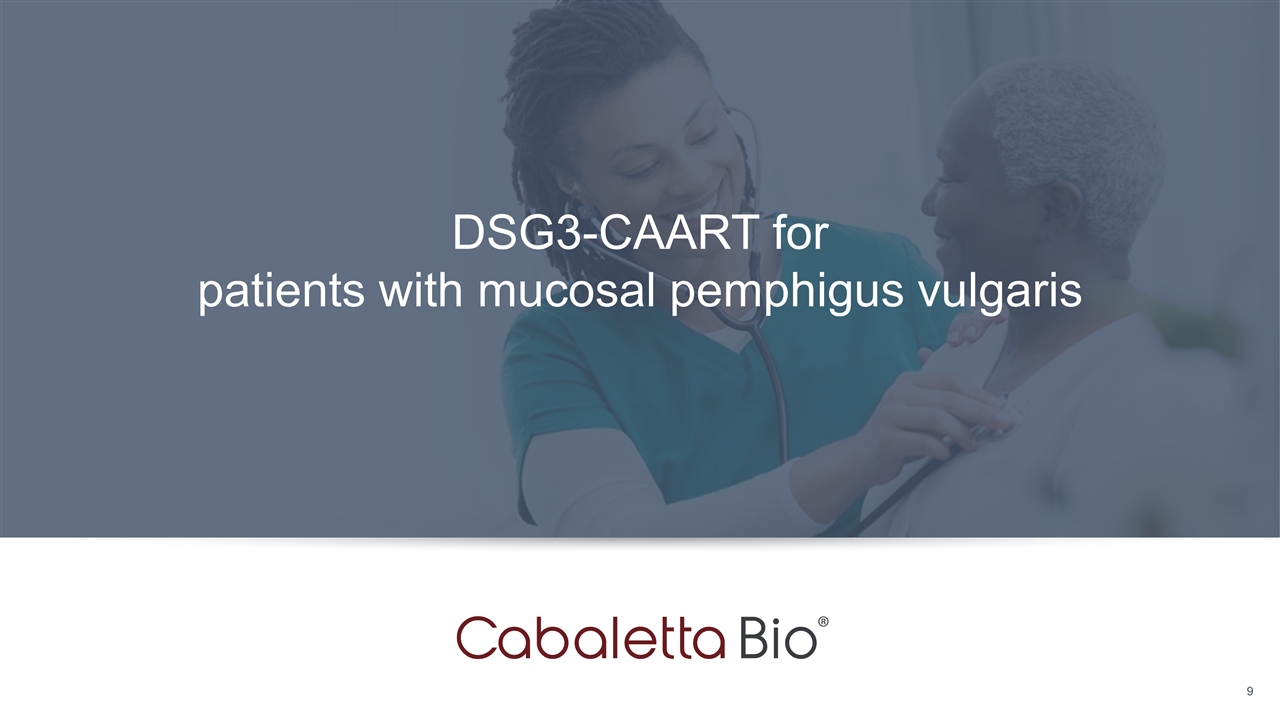
DSG3-CAART for patients with mucosal pemphigus vulgaris
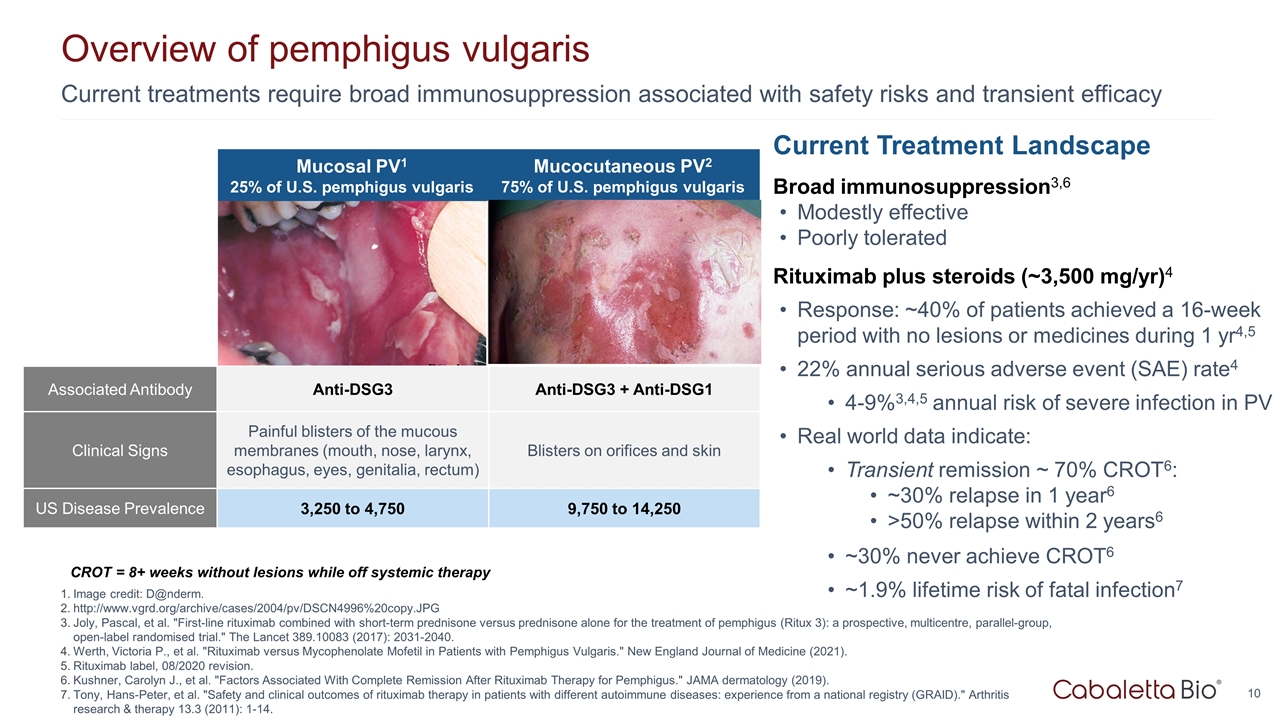
Current treatments require broad immunosuppression associated with safety risks and transient efficacy Overview of pemphigus vulgaris Image credit: D@nderm. http://www.vgrd.org/archive/cases/2004/pv/DSCN4996%20copy.JPG Joly, Pascal, et al. "First-line rituximab combined with short-term prednisone versus prednisone alone for the treatment of pemphigus (Ritux 3): a prospective, multicentre, parallel-group, open-label randomised trial." The Lancet 389.10083 (2017): 2031-2040. Werth, Victoria P., et al. "Rituximab versus Mycophenolate Mofetil in Patients with Pemphigus Vulgaris." New England Journal of Medicine (2021). Rituximab label, 08/2020 revision. Kushner, Carolyn J., et al. "Factors Associated With Complete Remission After Rituximab Therapy for Pemphigus." JAMA dermatology (2019). Tony, Hans-Peter, et al. "Safety and clinical outcomes of rituximab therapy in patients with different autoimmune diseases: experience from a national registry (GRAID)." Arthritis research & therapy 13.3 (2011): 1-14. Current Treatment Landscape Broad immunosuppression3,6 Modestly effective Poorly tolerated Rituximab plus steroids (~3,500 mg/yr)4 Response: ~40% of patients achieved a 16-week period with no lesions or medicines during 1 yr4,5 22% annual serious adverse event (SAE) rate4 4-9%3,4,5 annual risk of severe infection in PV Real world data indicate: Transient remission ~ 70% CROT6: ~30% relapse in 1 year6 >50% relapse within 2 years6 ~30% never achieve CROT6 ~1.9% lifetime risk of fatal infection7 CROT = 8+ weeks without lesions while off systemic therapy http://www.danderm-pdv.is.kkh.dk/atlas/3-157.html http://www.dermis.net/bilder/CD008/550px/img0042.jpg Mucosal PV1 25% of U.S. pemphigus vulgaris Mucocutaneous PV2 75% of U.S. pemphigus vulgaris Associated Antibody Anti-DSG3 Anti-DSG3 + Anti-DSG1 Clinical Signs Painful blisters of the mucous membranes (mouth, nose, larynx, esophagus, eyes, genitalia, rectum) Blisters on orifices and skin US Disease Prevalence 3,250 to 4,750 9,750 to 14,250
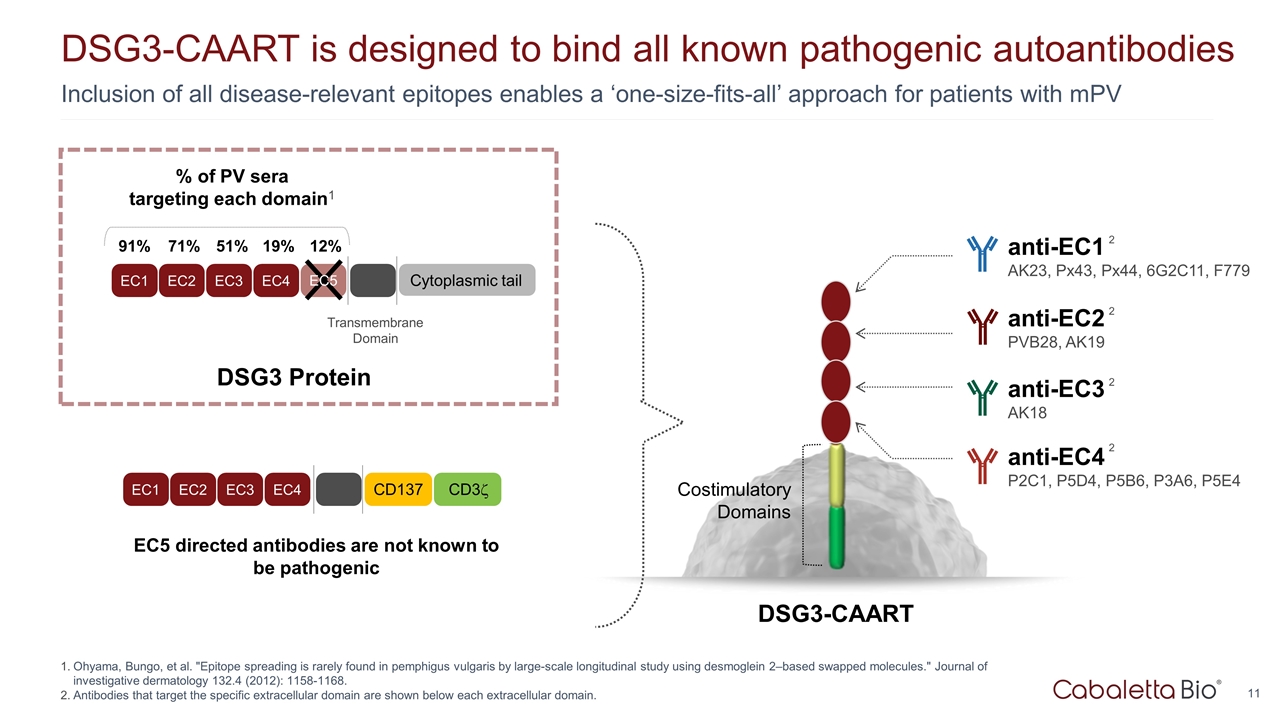
Inclusion of all disease-relevant epitopes enables a ‘one-size-fits-all’ approach for patients with mPV DSG3-CAART is designed to bind all known pathogenic autoantibodies Ohyama, Bungo, et al. "Epitope spreading is rarely found in pemphigus vulgaris by large-scale longitudinal study using desmoglein 2–based swapped molecules." Journal of investigative dermatology 132.4 (2012): 1158-1168. Antibodies that target the specific extracellular domain are shown below each extracellular domain. EC5 directed antibodies are not known to be pathogenic DSG3-CAART Costimulatory Domains anti-EC4 P2C1, P5D4, P5B6, P3A6, P5E4 2 anti-EC3 AK18 2 anti-EC2 PVB28, AK19 2 anti-EC1 AK23, Px43, Px44, 6G2C11, F779 2 EC1 EC2 EC3 EC4 Transmembrane Domain Cytoplasmic tail % of PV sera targeting each domain1 91% 71% 51% 19% 12% EC5 EC1 EC2 EC3 EC4 CD137 CD3z DSG3 Protein
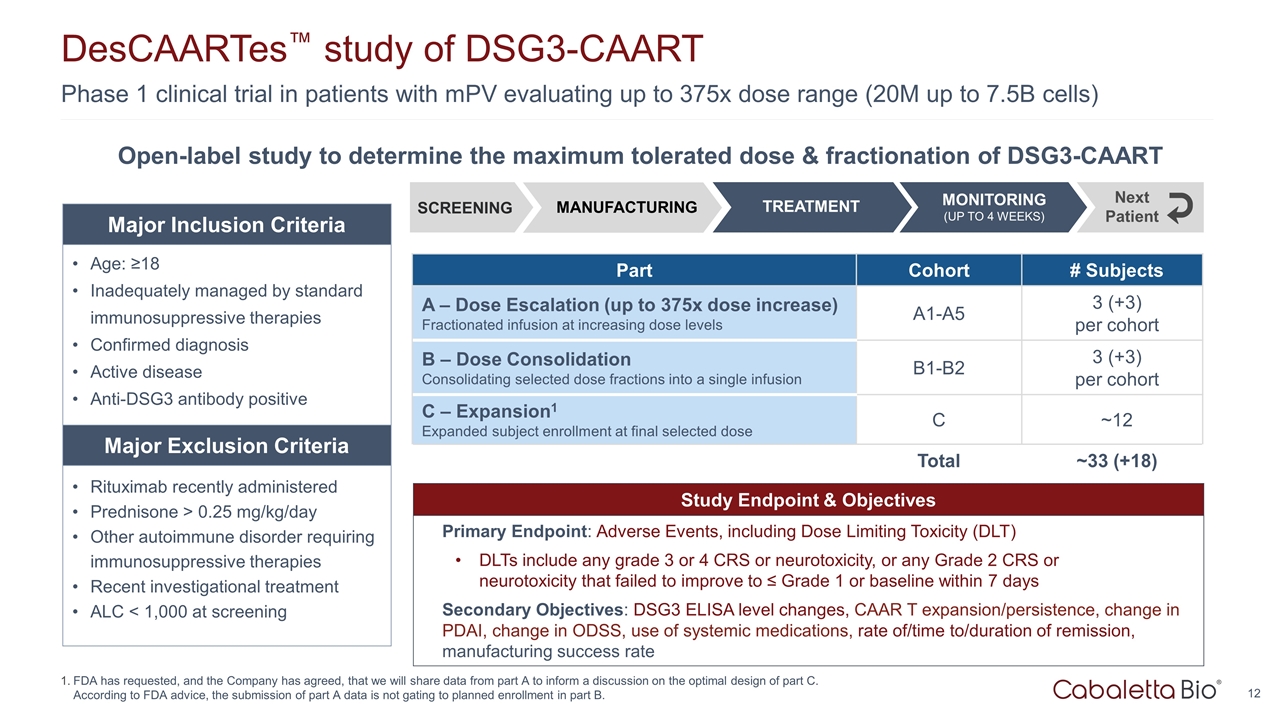
Phase 1 clinical trial in patients with mPV evaluating up to 375x dose range (20M up to 7.5B cells) DesCAARTes™ study of DSG3-CAART FDA has requested, and the Company has agreed, that we will share data from part A to inform a discussion on the optimal design of part C. According to FDA advice, the submission of part A data is not gating to planned enrollment in part B. Study Endpoint & Objectives Primary Endpoint: Adverse Events, including Dose Limiting Toxicity (DLT) DLTs include any grade 3 or 4 CRS or neurotoxicity, or any Grade 2 CRS or neurotoxicity that failed to improve to ≤ Grade 1 or baseline within 7 days Secondary Objectives: DSG3 ELISA level changes, CAAR T expansion/persistence, change in PDAI, change in ODSS, use of systemic medications, rate of/time to/duration of remission, manufacturing success rate Open-label study to determine the maximum tolerated dose & fractionation of DSG3-CAART Part Cohort # Subjects A – Dose Escalation (up to 375x dose increase) Fractionated infusion at increasing dose levels A1-A5 3 (+3) per cohort B – Dose Consolidation Consolidating selected dose fractions into a single infusion B1-B2 3 (+3) per cohort C – Expansion1 Expanded subject enrollment at final selected dose C ~12 Total ~33 (+18) Age: ≥18 Inadequately managed by standard immunosuppressive therapies Confirmed diagnosis Active disease Anti-DSG3 antibody positive Rituximab recently administered Prednisone > 0.25 mg/kg/day Other autoimmune disorder requiring immunosuppressive therapies Recent investigational treatment ALC < 1,000 at screening Major Inclusion Criteria Major Exclusion Criteria SCREENING MONITORING (UP TO 4 WEEKS) TREATMENT (~1 WEEK) Next Patient MANUFACTURING TREATMENT
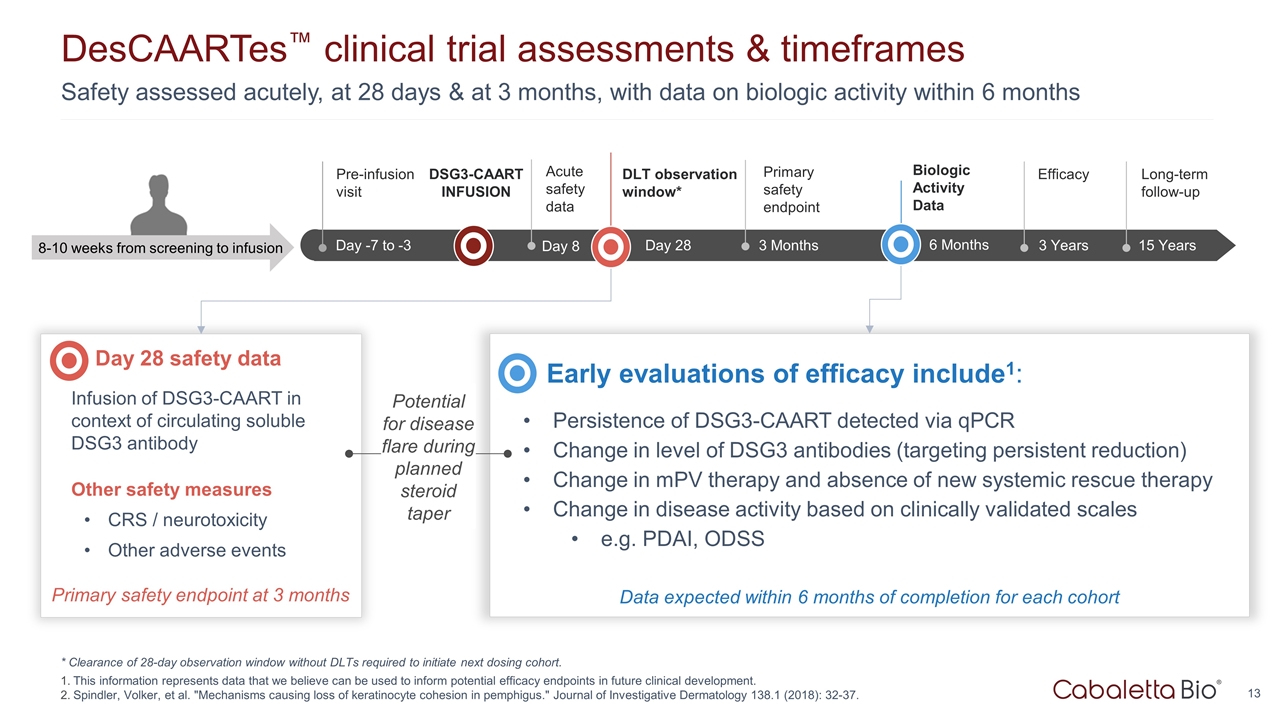
Safety assessed acutely, at 28 days & at 3 months, with data on biologic activity within 6 months DesCAARTes™ clinical trial assessments & timeframes * Clearance of 28-day observation window without DLTs required to initiate next dosing cohort. This information represents data that we believe can be used to inform potential efficacy endpoints in future clinical development. Spindler, Volker, et al. "Mechanisms causing loss of keratinocyte cohesion in pemphigus." Journal of Investigative Dermatology 138.1 (2018): 32-37. Up to Wk -18 Wk -18 to -1 Day -7 to -3 Pre-infusion visit 3 Years Efficacy 15 Years Long-term follow-up 3 Months Primary safety endpoint 8-10 weeks from screening to infusion DSG3-CAART INFUSION Day 28 safety data Infusion of DSG3-CAART in context of circulating soluble DSG3 antibody Other safety measures CRS / neurotoxicity Other adverse events Early evaluations of efficacy include1: Persistence of DSG3-CAART detected via qPCR Change in level of DSG3 antibodies (targeting persistent reduction) Change in mPV therapy and absence of new systemic rescue therapy Change in disease activity based on clinically validated scales e.g. PDAI, ODSS Primary safety endpoint at 3 months Potential for disease flare during planned steroid taper DLT observation window* 6 Months Biologic Activity Data Data expected within 6 months of completion for each cohort Day 28 Day 8 Acute safety data
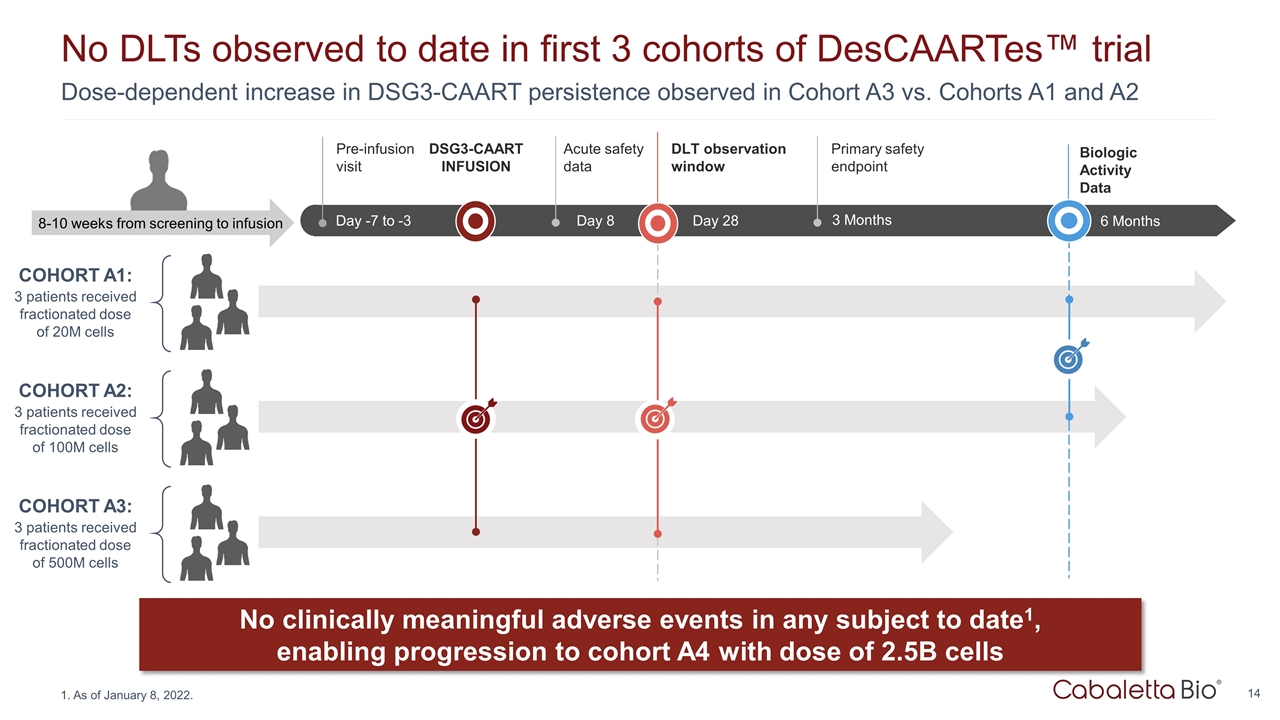
Dose-dependent increase in DSG3-CAART persistence observed in Cohort A3 vs. Cohorts A1 and A2 No DLTs observed to date in first 3 cohorts of DesCAARTes™ trial As of January 8, 2022. No clinically meaningful adverse events in any subject to date1, enabling progression to cohort A4 with dose of 2.5B cells COHORT A1: 3 patients received fractionated dose of 20M cells COHORT A2: 3 patients received fractionated dose of 100M cells Up to Wk -18 Wk -18 to -1 Day -7 to -3 Pre-infusion visit Day 8 Acute safety data 8-10 weeks from screening to infusion DSG3-CAART INFUSION Day 28 DLT observation window 3 Months Primary safety endpoint 6 Months Biologic Activity Data COHORT A3: 3 patients received fractionated dose of 500M cells
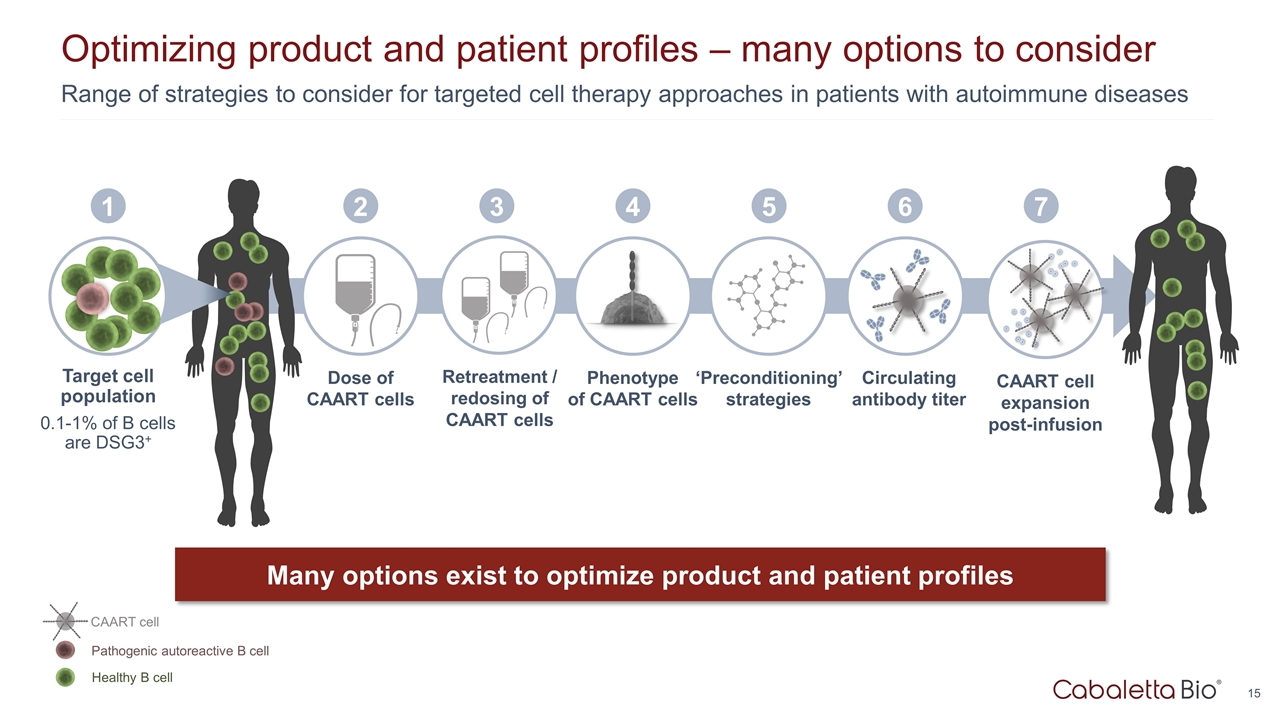
Dose of CAART cells 2 CAART cell expansion post-infusion 3 Range of strategies to consider for targeted cell therapy approaches in patients with autoimmune diseases Optimizing product and patient profiles – many options to consider Many options exist to optimize product and patient profiles Target cell population 0.1-1% of B cells are DSG3+ 1 Healthy B cell Pathogenic autoreactive B cell CAART cell Phenotype of CAART cells 4 Circulating antibody titer 6 5 ‘Preconditioning’ strategies Retreatment / redosing of CAART cells 7
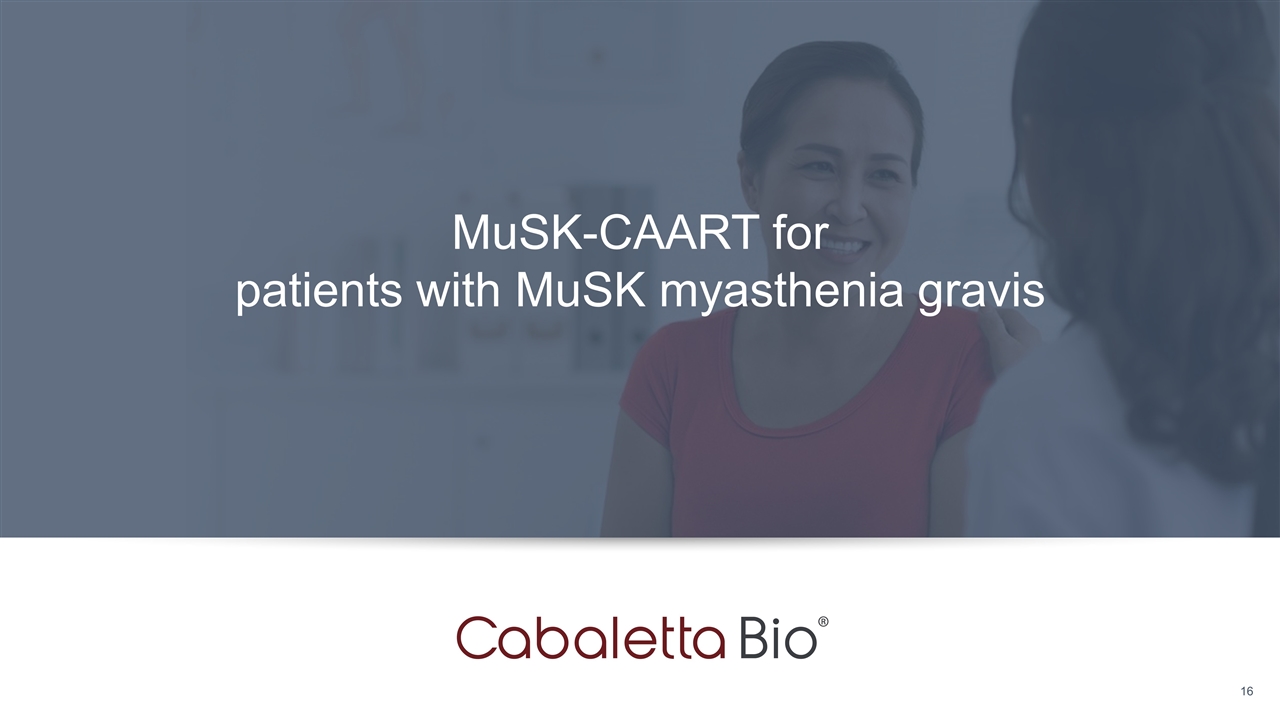
MuSK-CAART for patients with MuSK myasthenia gravis
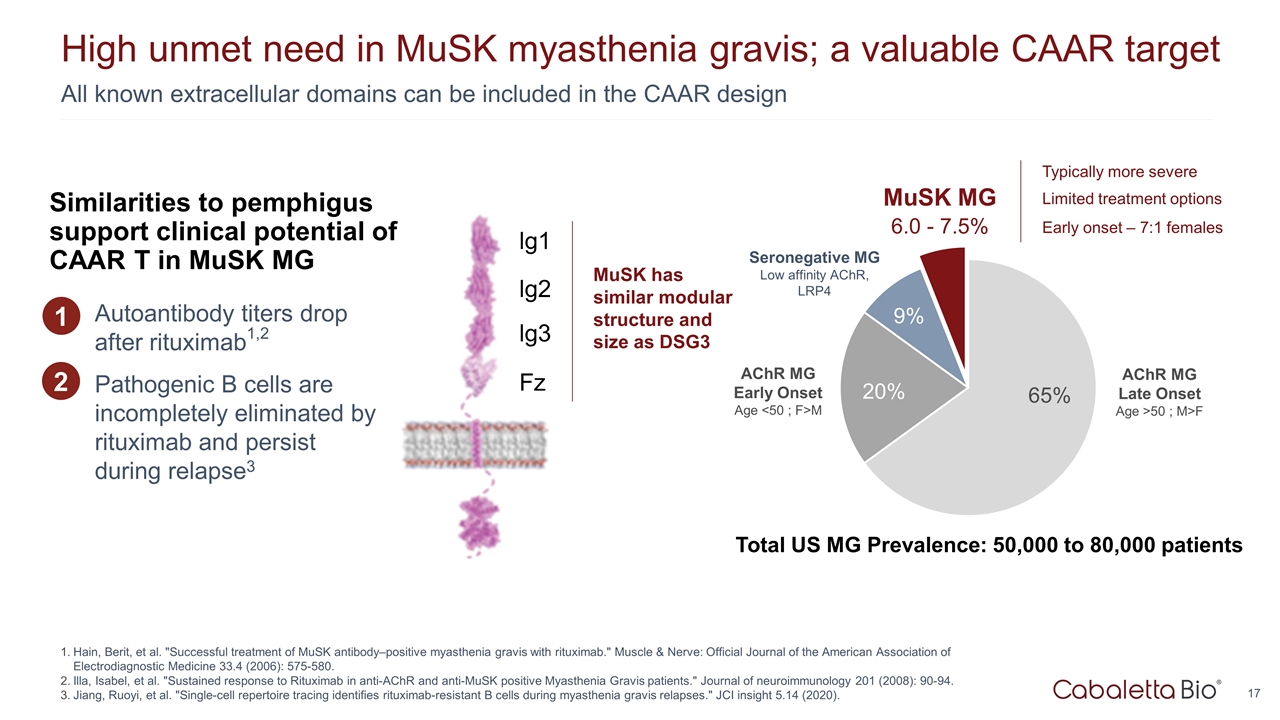
6.0 - 7.5% All known extracellular domains can be included in the CAAR design High unmet need in MuSK myasthenia gravis; a valuable CAAR target Hain, Berit, et al. "Successful treatment of MuSK antibody–positive myasthenia gravis with rituximab." Muscle & Nerve: Official Journal of the American Association of Electrodiagnostic Medicine 33.4 (2006): 575-580. Illa, Isabel, et al. "Sustained response to Rituximab in anti-AChR and anti-MuSK positive Myasthenia Gravis patients." Journal of neuroimmunology 201 (2008): 90-94. Jiang, Ruoyi, et al. "Single-cell repertoire tracing identifies rituximab-resistant B cells during myasthenia gravis relapses." JCI insight 5.14 (2020). AChR MG Early Onset Age <50 ; F>M AChR MG Late Onset Age >50 ; M>F MuSK MG Seronegative MG Low affinity AChR, LRP4 Total US MG Prevalence: 50,000 to 80,000 patients Typically more severe Limited treatment options Early onset – 7:1 females MuSK has similar modular structure and size as DSG3 lg1 lg2 lg3 Fz Autoantibody titers drop after rituximab1,2 Pathogenic B cells are incompletely eliminated by rituximab and persist during relapse3 1 Similarities to pemphigus support clinical potential of CAAR T in MuSK MG 2
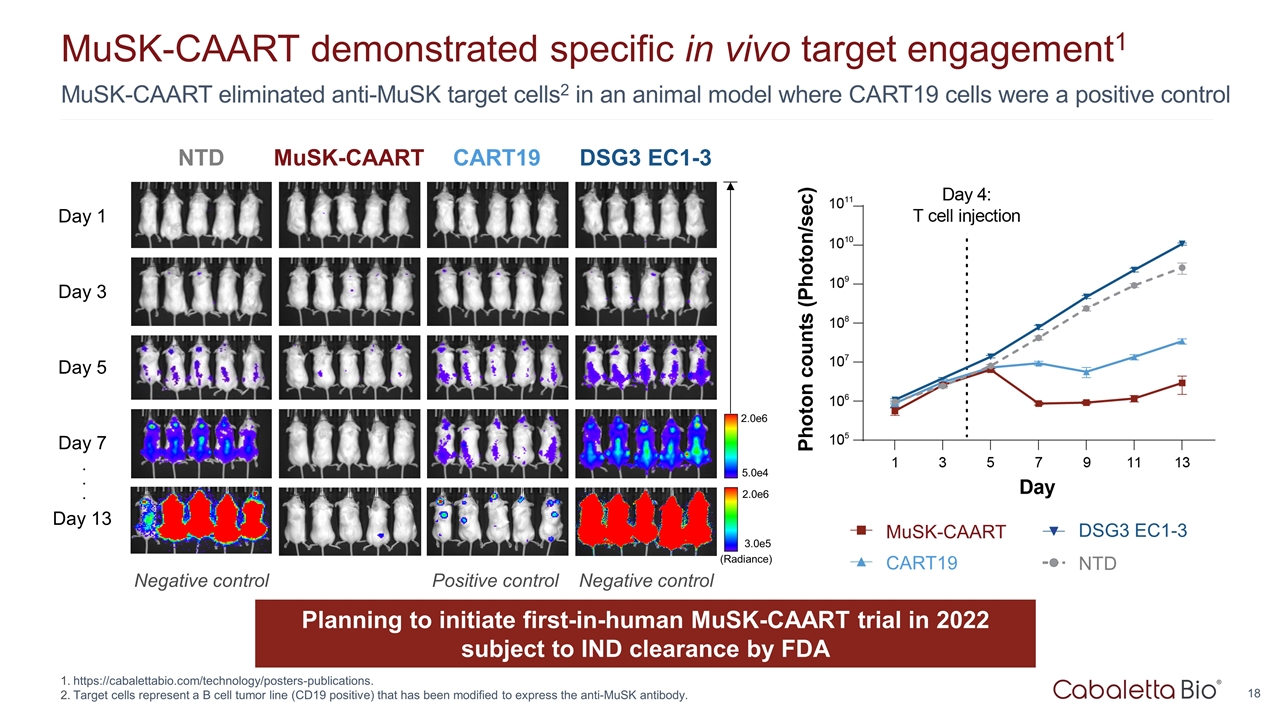
MuSK-CAART eliminated anti-MuSK target cells2 in an animal model where CART19 cells were a positive control MuSK-CAART demonstrated specific in vivo target engagement1 https://cabalettabio.com/technology/posters-publications. Target cells represent a B cell tumor line (CD19 positive) that has been modified to express the anti-MuSK antibody. MuSK-CAART CART19 DSG3 EC1-3 Day 1 Day 3 Day 5 Day 7 Day 13 5.0e4 2.0e6 (Radiance) 3.0e5 2.0e6 . . . NTD Positive control Negative control Negative control CART19 MuSK-CAART DSG3 EC1-3 NTD Planning to initiate first-in-human MuSK-CAART trial in 2022 subject to IND clearance by FDA

PLA2R-CAART for patients with PLA2R-associated membranous nephropathy
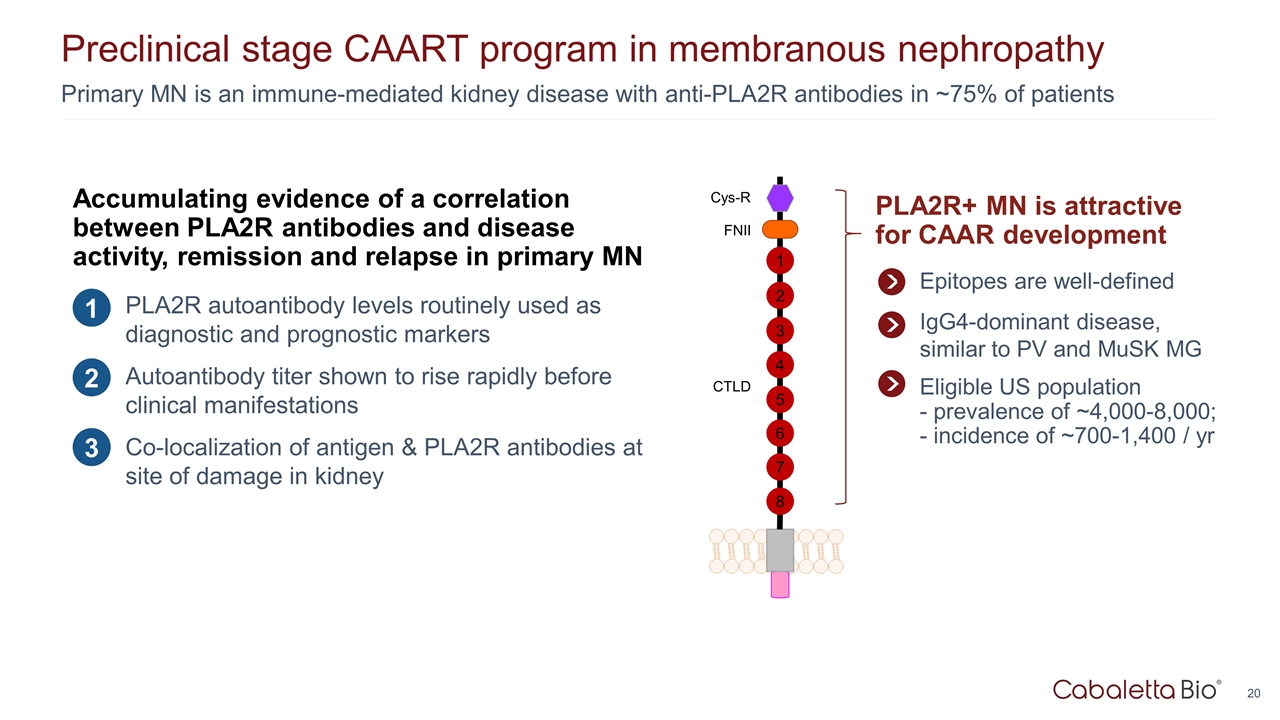
Primary MN is an immune-mediated kidney disease with anti-PLA2R antibodies in ~75% of patients Preclinical stage CAART program in membranous nephropathy Accumulating evidence of a correlation between PLA2R antibodies and disease activity, remission and relapse in primary MN PLA2R autoantibody levels routinely used as diagnostic and prognostic markers Autoantibody titer shown to rise rapidly before clinical manifestations Co-localization of antigen & PLA2R antibodies at site of damage in kidney 1 2 3 Cys-R FNII CTLD 1 2 3 4 5 6 7 8 PLA2R+ MN is attractive for CAAR development Epitopes are well-defined IgG4-dominant disease, similar to PV and MuSK MG Eligible US population - prevalence of ~4,000-8,000; - incidence of ~700-1,400 / yr
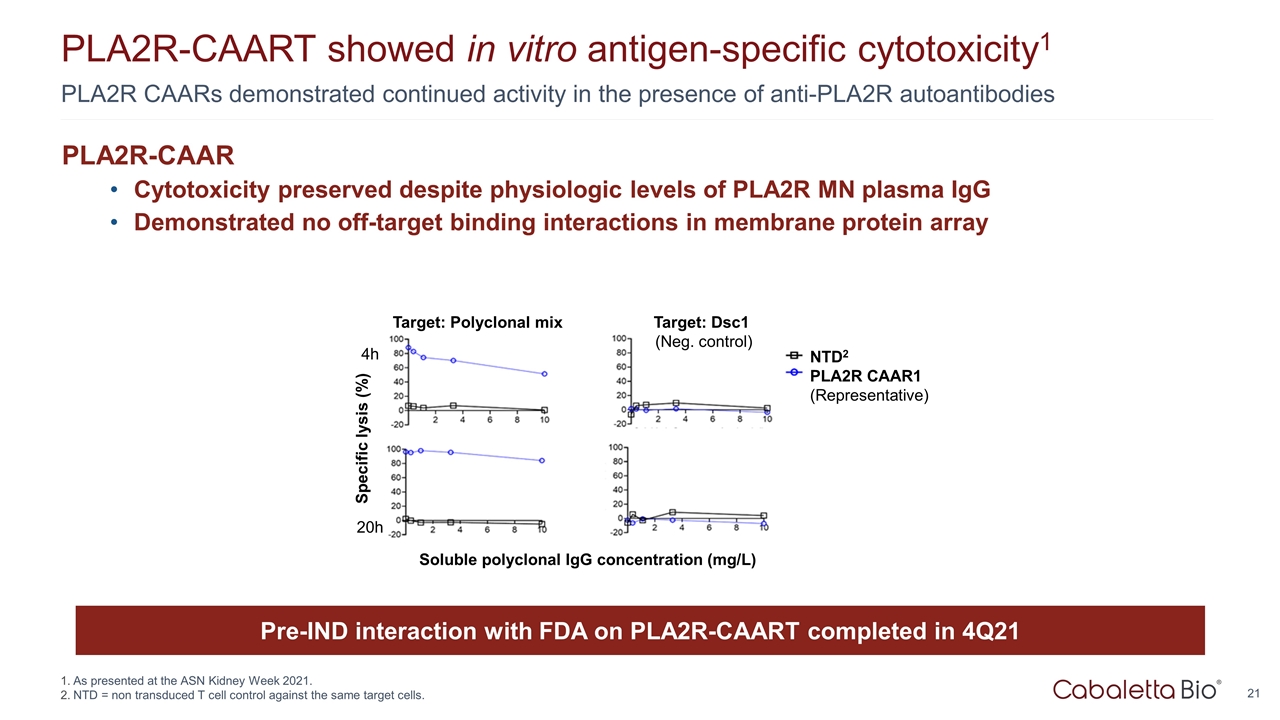
PLA2R CAARs demonstrated continued activity in the presence of anti-PLA2R autoantibodies PLA2R-CAART showed in vitro antigen-specific cytotoxicity1 As presented at the ASN Kidney Week 2021. NTD = non transduced T cell control against the same target cells. PLA2R-CAAR Cytotoxicity preserved despite physiologic levels of PLA2R MN plasma IgG Demonstrated no off-target binding interactions in membrane protein array Soluble polyclonal IgG concentration (mg/L) Specific lysis (%) Target: Polyclonal mix Target: Dsc1 (Neg. control) 4h 20h NTD2 PLA2R CAAR1 (Representative) Pre-IND interaction with FDA on PLA2R-CAART completed in 4Q21

Manufacturing
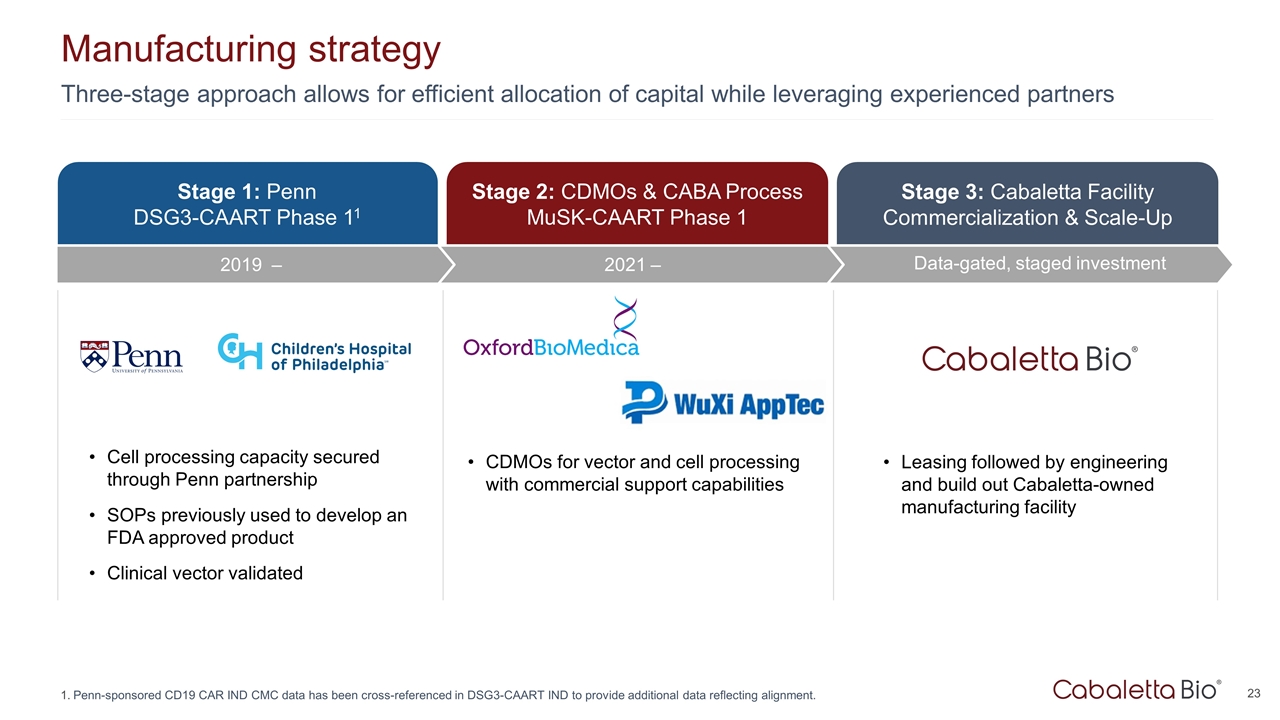
Three-stage approach allows for efficient allocation of capital while leveraging experienced partners Manufacturing strategy Penn-sponsored CD19 CAR IND CMC data has been cross-referenced in DSG3-CAART IND to provide additional data reflecting alignment. Stage 3: Cabaletta Facility Commercialization & Scale-Up Data-gated, staged investment Stage 1: Penn DSG3-CAART Phase 11 Stage 2: CDMOs & CABA Process MuSK-CAART Phase 1 Cell processing capacity secured through Penn partnership SOPs previously used to develop an FDA approved product Clinical vector validated CDMOs for vector and cell processing with commercial support capabilities Leasing followed by engineering and build out Cabaletta-owned manufacturing facility 2021 – 2019 –

Corporate Summary

BOARD OF DIRECTORS Cabaletta Bio leadership LEADERSHIP TEAM Anup Marda Chief Financial Officer Arun Das, M.D. Chief Business Officer David J. Chang, M.D., M.P.H. Chief Medical Officer Martha O’Connor Chief HR Officer Michael Gerard General Counsel Steven Nichtberger, M.D. President, CEO & Chairman Aimee Payne, M.D., Ph.D. Co-Founder and Co-Chair Michael C. Milone, M.D., Ph.D. Co-Founder and Co-Chair Carl June, M.D. Jay Siegel, M.D. Brian Daniels, M.D. Heather Harte-Hall Chief Compliance Officer Samik Basu, M.D. Chief Scientific Officer Gwendolyn Binder, Ph.D. President, Science & Technology SCIENTIFIC ADVISORY BOARD Steven Nichtberger, M.D. Richard Henriques, M.B.A. Scott Brun, M.D. Mark Simon, M.B.A. Catherine Bollard, M.D. Drew Weissman, M.D., Ph.D. Iain McInnes, Ph.D., FRCP, FRSE, FMedSci
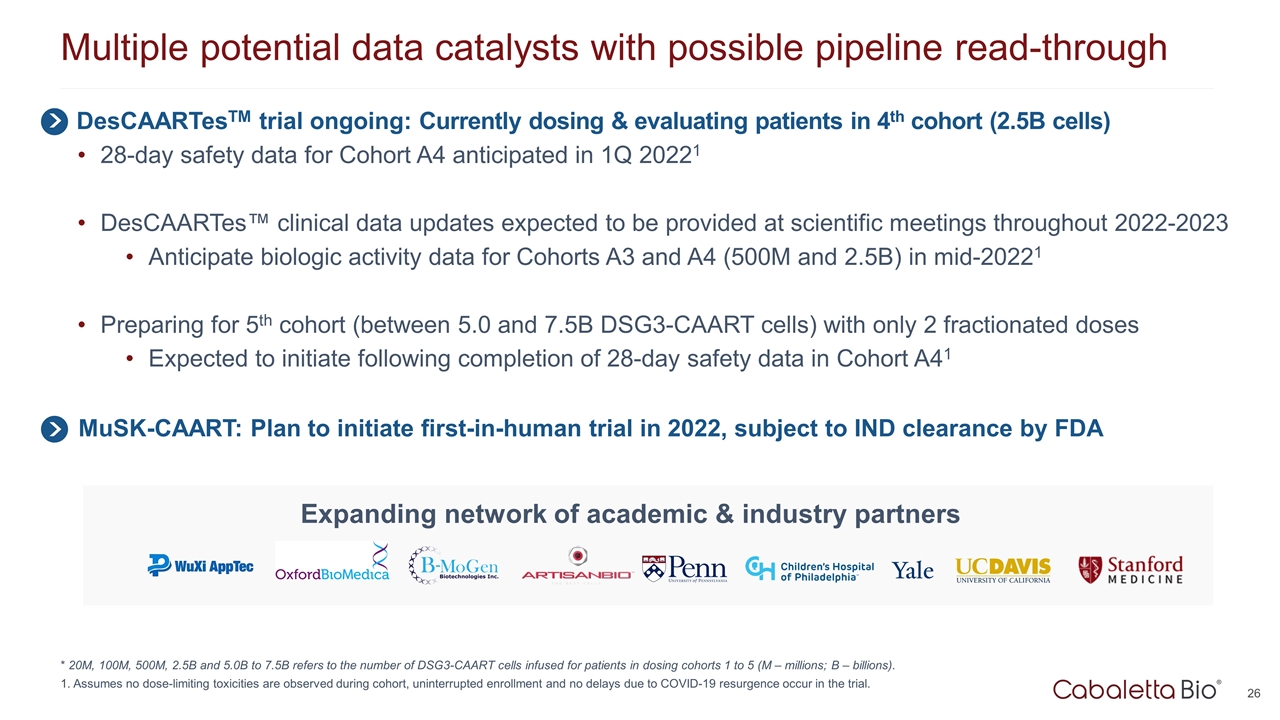
Multiple potential data catalysts with possible pipeline read-through * 20M, 100M, 500M, 2.5B and 5.0B to 7.5B refers to the number of DSG3-CAART cells infused for patients in dosing cohorts 1 to 5 (M – millions; B – billions). Assumes no dose-limiting toxicities are observed during cohort, uninterrupted enrollment and no delays due to COVID-19 resurgence occur in the trial. DesCAARTesTM trial ongoing: Currently dosing & evaluating patients in 4th cohort (2.5B cells) 28-day safety data for Cohort A4 anticipated in 1Q 20221 DesCAARTes™ clinical data updates expected to be provided at scientific meetings throughout 2022-2023 Anticipate biologic activity data for Cohorts A3 and A4 (500M and 2.5B) in mid-20221 Preparing for 5th cohort (between 5.0 and 7.5B DSG3-CAART cells) with only 2 fractionated doses Expected to initiate following completion of 28-day safety data in Cohort A41 MuSK-CAART: Plan to initiate first-in-human trial in 2022, subject to IND clearance by FDA Expanding network of academic & industry partners

Develop and launch the first curative targeted cellular therapies for patients with autoimmune diseases
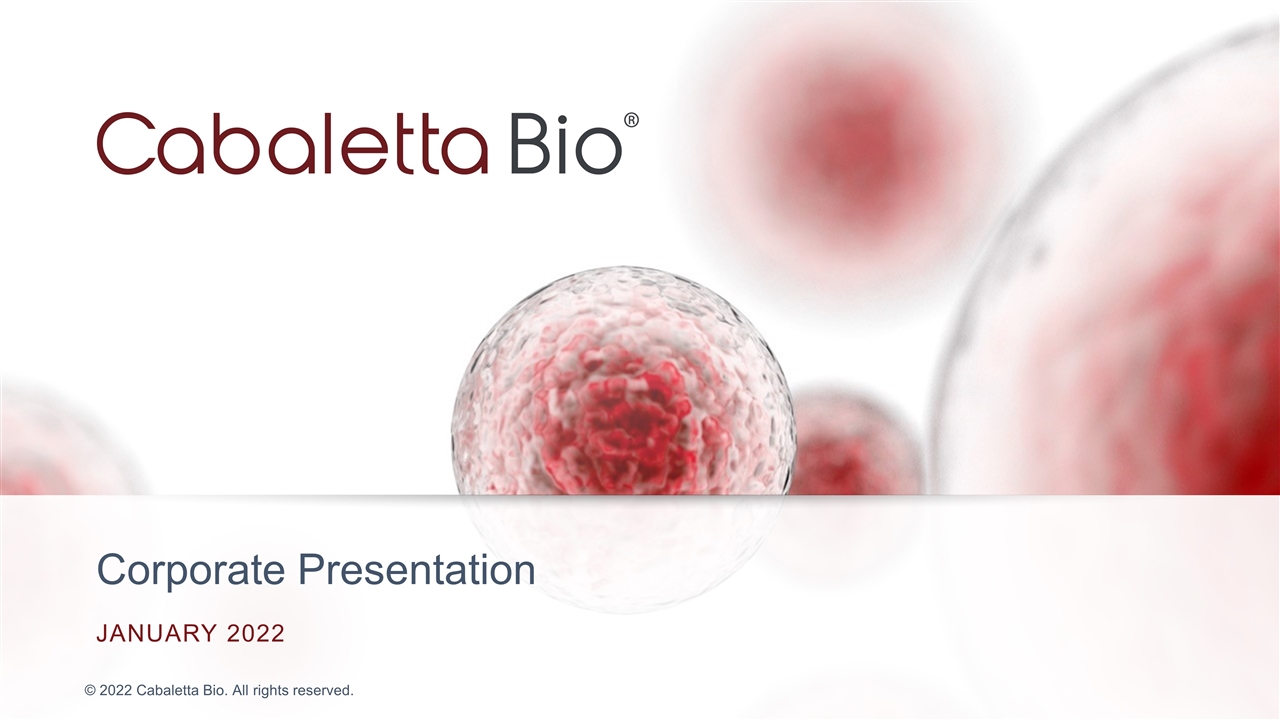
Corporate Presentation JANUARY 2022
Serious News for Serious Traders! Try StreetInsider.com Premium Free!
You May Also Be Interested In
- Pre-Investor Call Presentation available to shareholders
- New CPS Protection Platform: TXOne Networks Presents SageOne in Hannover
- Municipality Finance issues a GBP 50 million tap under its MTN programme
Create E-mail Alert Related Categories
SEC FilingsSign up for StreetInsider Free!
Receive full access to all new and archived articles, unlimited portfolio tracking, e-mail alerts, custom newswires and RSS feeds - and more!



 Tweet
Tweet Share
Share